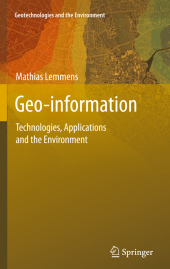 Neuerscheinungen 2013Stand: 2020-01-07 |
Schnellsuche
ISBN/Stichwort/Autor
|
Herderstraße 10
10625 Berlin
Tel.: 030 315 714 16
Fax 030 315 714 14
info@buchspektrum.de |

Mathias Lemmens
Geo-information
Technologies, Applications and the Environment
2011. 2013. xxii, 350 S. XXII, 350 p. 235 mm
Verlag/Jahr: SPRINGER NETHERLANDS; SPRINGER, BERLIN 2013
ISBN: 9400737815 (9400737815)
Neue ISBN: 978-9400737815 (9789400737815)
Preis und Lieferzeit: Bitte klicken
Geomatics is one geoscience discipline that has seen major changes in the last decade. This book is a unique and in-depth survey of the field and covers all three strands of this rapidly developing field - applications, information technology and surveying.
Geomatics, the handling and processing of information and data about the Earth, is one geoscience discipline that has seen major changes in the last decade, as mapping and observation systems become ever more sensitive and sophisticated. This book is a unique and in-depth survey of the field, which has a central role to play in tackling a host of environmental issues faced by society. Covering all three strands of geomatics - applications, information technology and surveying - the chapters cover the history and background of the subject, the technology employed both to collect and disseminate data, and the varied applications to which geomatics can be put, including urban planning, assessment of biodiversity, disaster management and land administration. Relevant professionals, as well as students in a variety of disciplines such as geography and surveying, will find this book required reading.
This rapidly developing field uses increasingly complex and accurate systems. Today, technology enables us to capture geo-data in full 3D as well as to disseminate it via the Web at the speed of light. We are able to continuously image the world from space at resolutions of up to 50 cm. Airborne LiDAR (laser surveying) sensors can be combined with digital camera technology to produce geometrically correct images of the Earth´s surface, while integrating these with large-scale topographic maps and terrestrial as well as aerial images to produce 3D cityscapes that computer users can explore from their desktops.
Preface
1. Geo-information Technology - What It Is, How It Was and Where It Is Heading
2. Earth Viewers
3. Understanding Earth-related Phenomena through Maps
4. Global Navigation Satellite Systems and Inertial Navigation
5. Mobile GIS and Location-based Services
6. Terrestrial Laser Scanning
7. Photogrammetry: Geometric Data from Imagery
8. Airborne Lidar
9. Earth Observation from Space
10. Modelling and Exchanging Geo-information
11. Quality of Geo-information
12. Applying Geo-information Technology
13. Census Taking
14. Risk and Disaster Management
15. Land Administration
Index
From the reviews:
"This book provides a broad survey of the basics and applications of geoinformation, a topic with long history and great vitality of late. ... The volume has a wide potential audience. It could serve as the basis for an undergraduate course in geoinformation or as a resource for graduate students and faculty wishing to develop more background in this area. It is also useful for laypersons interested in geospatial technologies and practitioners. Summing Up: Recommended. Academic, general, and professional audiences, all levels." (R. A. Kolvoord, Choice, Vol. 49 (6), February, 2012)


